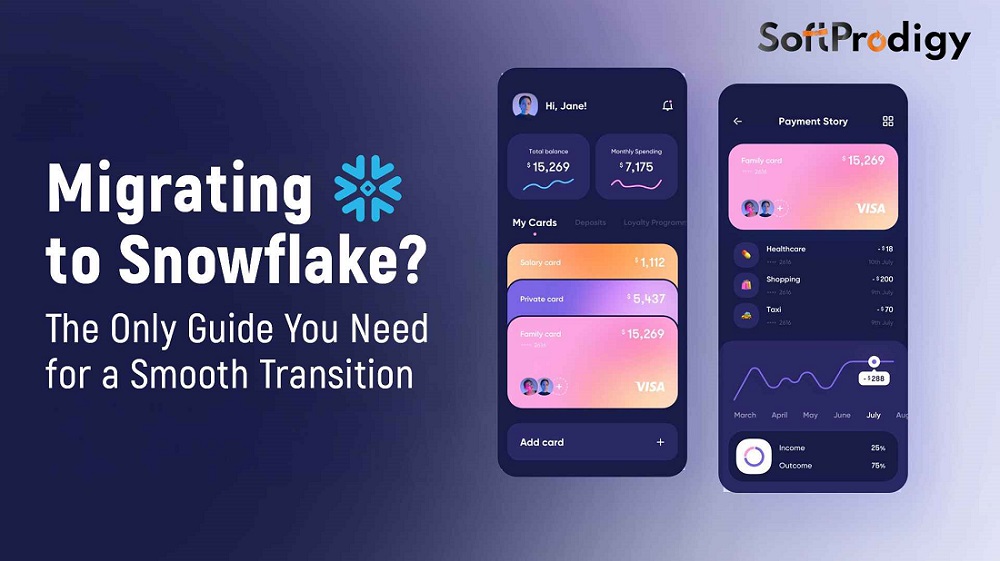Ever wondered what’s holding your business data back? If slow queries, storage limits, or security concerns sound familiar, it might be time for an upgrade. Moving to Snowflake could be the solution you need.
But here’s the catch – without a well-planned migration, you could end up with downtime, data loss, and mounting costs. That’s why partnering with a Snowflake data migration company can make all the difference, ensuring a seamless transition with zero disruptions.
- Enterprises quadrupled their use of key governance tools in the data cloud, resulting in a nearly 150% increase in data usage in 2024.
- Snowflake has over 11,000 global customers, out of which 745 are from Forbes’ Global 2000 list.
- In its most recent fiscal quarter, Snowflake recorded revenue of $986.8 million, above experts’ projections and suggesting strong market demand for its services.
This blog will tell you everything you need to know about a seamless data transition. If you’re looking for Snowflake data migration services, you’ll also find tips on selecting the right provider.
Why Move to Snowflake?
Snowflake is a cloud data platform designed for high scalability, rapid query performance, and strong security. Companies that work with massive datasets or require real-time analytics benefit from its multi-cluster design, which isolates storage and computing to efficiently manage resources.
Operations could experience disruptions due to different data errors that create performance slowdowns and security breaches. Thus, organization performance declines when data design ignores proper standards because it leads to storage expenses rising while slowing down query speed and causing data duplication.
Such problems can be prevented by a Snowflake data migration company that can simplify data structures, properly index large tables, and ensure seamless data movement while minimizing downtime.
Expert advice integrated with a strategic planning process enables organizations to reach maximum Snowflake capabilities without risks of migration issues.
6 Steps to a Smooth Snowflake Data Migration
Migration to Snowflake is an intelligent decision for improved data management, quick analytics, and reduced costs. Below are the major steps towards a successful migration:
Step 1. Define Your Goals
Before moving data, set clear objectives. Are you looking for better query speed, cost savings, or improved scalability? Defining these goals helps create an efficient migration plan. A Snowflake data migration company aligns the transition with business requirements.
For instance, an e-commerce company migrating to Snowflake to handle peak-season traffic needs to optimize database structures accordingly. Without setting this objective, they might overlook crucial adjustments.
Step 2. Evaluate Your Existing Data
All data does not have to be migrated as it is. Some records are outdated, redundant, or need restructuring. Pre-analysis of data saves storage costs, when only useful information is moved.
A firm’s on average 33% of data is considered redundant. This simply means that pre-cleaning before migration saves storage costs and helps enhance query performance.
Step 3. Select the Proper Migration Method
Choosing an appropriate migration strategy is critical to ensuring a seamless move to Snowflake. The strategy is based on data complexity, system dependencies, and business objectives. There are three methods to consider:
• Lift and Shift: Migrates the data as-is to effect rapid migration with little modification. Suitable for companies requiring rapid deployment, but it could miss out on the full benefit of Snowflake.
• Re-architecture: Design data structures again to make performance better, minimize costs, and enhance scalability. Ideal for companies with out-of-date models, such as transport companies in need of real-time tracking.
• Hybrid Approach: Merges both of the above methods by transferring some data as it is and optimizing crucial workloads. Provides a mix of speed and efficiency.
Step 4. Plan for Downtime and Performance Impact
Migration can temporarily affect business operations. To minimize disruptions, schedule it during off-peak hours. For instance, a media company moving video analytics to Snowflake may schedule migration overnight to prevent service delays.
This ensures a smooth transition without affecting content delivery. Here, a reliable Snowflake data migration company can execute migration in phases to maintain business continuity.
Step 5. Data Validation and Testing
After migration, verifying data accuracy is essential, so check for missing records, incorrect mappings, and performance issues. Rigorous testing ensures the system functions correctly before full deployment.
For example, a healthcare provider can find discrepancies in patient records postmigration. That’s why running validation tests early helps fix errors before going live.
Step 6. Optimize for Performance
Once the migration is complete, fine-tuning workloads, security settings, and cost management improves efficiency. Here, optimization prevents excessive computing expenses and enhances speed.
Migration specialists can help identify cost-saving opportunities and reduce them while maintaining performance. Thus, it is better to rely on Snowflake data migration services in the USA.
Ready to Migrate to Snowflake Smoothly?
Let our experts manage your Snowflake migration—fast, secure, and stress-free.
Key Snowflake Migration Challenges to Watch Out For
While migrating to Snowflake boosts scalability, security, and performance, it also comes with challenges. Without careful planning, issues like data compatibility, compliance risks, and hidden costs can disrupt operations.
However, with the right strategy and expert support, these risks can be minimized. Here are some key challenges to keep in mind:

• Data Compatibility Issues
Different databases use varied formats. Some legacy systems require data transformation before migration. Without proper handling, errors or loss can occur. For instance, a manufacturing firm using outdated SQL servers may need to restructure tables before migration. Without this step, reports generated after migration can fail.
• Security and Compliance
Moving sensitive data requires encryption and strict access controls. Choosing Snowflake data migration services that follow industry regulations helps prevent security risks. This makes more sense to financial institutions and businesses that want to implement role-based access controls and encryption to comply with data protection laws during migration.
Snowflake charges based on usage, so unexpected costs can arise if queries and storage are not optimized. You may face rising costs after migration due to inefficient queries. Continuous monitoring prevents overspending. Here, a Snowflake data migration company can optimize query performance, reducing unnecessary expenses.
4 Common Mistakes to Avoid During Snowflake Data Migration
While it may seem a matter of simple planning, data migration is, in fact, potentially troublesome and may involve operational interruptions, security breaches, and poor performance. Many of these common pitfalls are easy to eliminate with appropriate forethought and proper execution. These include:
1. Underestimating the Scale
Migration is usually more involved than anticipated. Most companies underestimate the effort and resources needed, resulting in rushed moves and forgotten details. Performing a proper checkup in advance can avoid last-minute headaches.
2. Missing Testing
Haste in the testing process can produce hidden bugs, causing data inconsistencies and performance issues. Therefore, testing must encompass data integrity checks, load testing, and realistic simulations to identify possible problems early.
3. Overlooking Data Quality
If your data is untidy prior to migration, it will remain so afterward. Cleaning, deduplicating, and organizing data in advance will make the data more structured. Moreover, it makes the transition more cost- and time-effective.
4. Neglecting Training
Employees must know how to work in Snowflake effectively. This is where proper training helps teams use Snowflake features optimally. It ultimately minimizes downtime and maximizes productivity.
Bonus: A Few Important Post-Migration Considerations
Post-data migration requires ongoing maintenance because it ensures peak system performance together with both security and user-friendly characteristics. Businesses achieve peak platform returns through post-migration support services provided by an effective Snowflake data migration company.
Efforts should center on three fundamental aspects: the optimization of performance, security measures, and improved user assistance, which represent the core targets to consider in the long term.
• Performance Tuning
The optimization process improves both query speed and resource distribution, which leads to lowered operational expenses. Monitoring workload patterns and adjusting configurations will help maintain efficiency as data usage evolves.
• Security Updates
The protection of data consists of permanent watches for encryption methods together with access controls and security compliance measurements. This comes along with constant updates for security. Remember that system vulnerabilities become security threats only after audit checks detect them before they materialize.
• User Support
Employees sometimes encounter obstacles when they try to use Snowflake’s operational elements and capabilities. This is where a specific team supports staff through quick problem resolution to minimize business interruptions as well as maintain operational continuity.
Choosing the Right Snowflake Data Migration Company
Successful execution of data movement to Snowflake depends heavily on selecting an appropriate data migration service provider. Correct provider selection reduces system outages while producing exact data results and boosts operational speed. Here are four fundamental elements to creating an informed decision:
1. Experience & Expertise
Your Snowflake data migration partner should demonstrate competence through its successful track record of large-scale industrial migrations. Here, company experience helps providers understand problems, simplifying their methods of implementation.
2. Security Standards
The provider you select should possess several essential security standards. Implementation can become quite tough if your provider is unable to provide the necessary security standards. The provider also needs to meet rigorous encryption standards as well as strict access control policies and all relevant industry compliance standards.
3. Certifications
Always choose a Snowflake Certified Professional who can help you ensure expert handling of your project with deep knowledge of Snowflake’s architecture, best practices, and performance optimization. With adherence to compliance standards and future-ready solutions, they deliver a seamless transition, making them the ideal choice for reliable data migration.
4. Custom Solutions
Every organization has a unique mode of operation and therefore requires a customized solution. A reliable service provider can help migrate existing infrastructure efficiently while taking into account the organization’s operational requirements.
5. Support
Proper support plays an essential role after migration because it provides necessary assistance to maintain system operational stability. Search for providers who give extended services beyond problem fixing and system performance tracking to help you reach future success.
Let’s Make a Move!
Migrating to Snowflake is a big step, but it doesn’t have to be a daunting one. With the right planning and the help of a certified Snowflake data migration company like SoftProdigy, you can make the transition smooth and stress-free.
Ready to make the move? Let’s get started!











